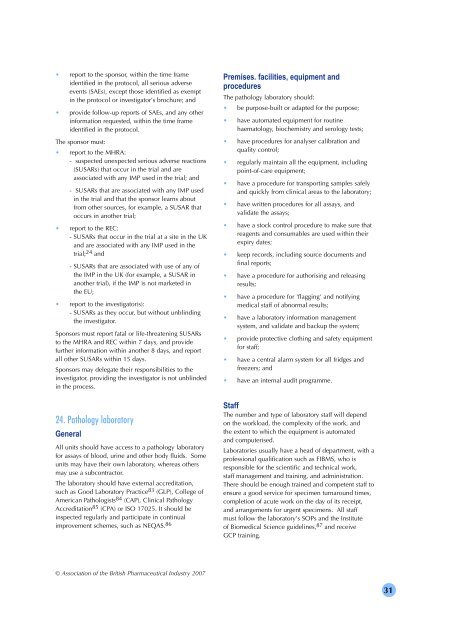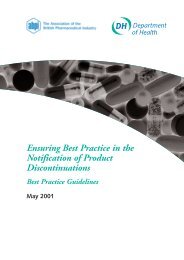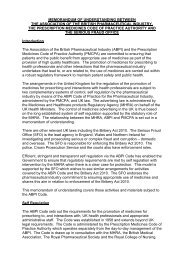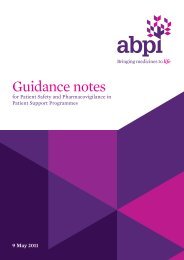ABPI Guidelines for Phase 1 Clinical Trials (PDF
ABPI Guidelines for Phase 1 Clinical Trials (PDF
ABPI Guidelines for Phase 1 Clinical Trials (PDF
Create successful ePaper yourself
Turn your PDF publications into a flip-book with our unique Google optimized e-Paper software.
• report to the sponsor, within the time frame<br />
identified in the protocol, all serious adverse<br />
events (SAEs), except those identified as exempt<br />
in the protocol or investigator's brochure; and<br />
• provide follow-up reports of SAEs, and any other<br />
in<strong>for</strong>mation requested, within the time frame<br />
identified in the protocol.<br />
The sponsor must:<br />
• report to the MHRA:<br />
- suspected unexpected serious adverse reactions<br />
(SUSARs) that occur in the trial and are<br />
associated with any IMP used in the trial; and<br />
- SUSARs that are associated with any IMP used<br />
in the trial and that the sponsor learns about<br />
from other sources, <strong>for</strong> example, a SUSAR that<br />
occurs in another trial;<br />
• report to the REC:<br />
- SUSARs that occur in the trial at a site in the UK<br />
and are associated with any IMP used in the<br />
trial; 24 and<br />
- SUSARs that are associated with use of any of<br />
the IMP in the UK (<strong>for</strong> example, a SUSAR in<br />
another trial), if the IMP is not marketed in<br />
the EU;<br />
• report to the investigator(s):<br />
- SUSARs as they occur, but without unblinding<br />
the investigator.<br />
Sponsors must report fatal or life-threatening SUSARs<br />
to the MHRA and REC within 7 days, and provide<br />
further in<strong>for</strong>mation within another 8 days, and report<br />
all other SUSARs within 15 days.<br />
Sponsors may delegate their responsibilities to the<br />
investigator, providing the investigator is not unblinded<br />
in the process.<br />
24. Pathology laboratory<br />
General<br />
All units should have access to a pathology laboratory<br />
<strong>for</strong> assays of blood, urine and other body fluids. Some<br />
units may have their own laboratory, whereas others<br />
may use a subcontractor.<br />
The laboratory should have external accreditation,<br />
such as Good Laboratory Practice 83 (GLP), College of<br />
American Pathologists 84 (CAP), <strong>Clinical</strong> Pathology<br />
Accreditation 85 (CPA) or ISO 17025. It should be<br />
inspected regularly and participate in continual<br />
improvement schemes, such as NEQAS. 86<br />
© Association of the British Pharmaceutical Industry 2007<br />
Premises. facilities, equipment and<br />
procedures<br />
The pathology laboratory should:<br />
• be purpose-built or adapted <strong>for</strong> the purpose;<br />
• have automated equipment <strong>for</strong> routine<br />
haematology, biochemistry and serology tests;<br />
• have procedures <strong>for</strong> analyser calibration and<br />
quality control;<br />
• regularly maintain all the equipment, including<br />
point-of-care equipment;<br />
• have a procedure <strong>for</strong> transporting samples safely<br />
and quickly from clinical areas to the laboratory;<br />
• have written procedures <strong>for</strong> all assays, and<br />
validate the assays;<br />
• have a stock control procedure to make sure that<br />
reagents and consumables are used within their<br />
expiry dates;<br />
• keep records, including source documents and<br />
final reports;<br />
• have a procedure <strong>for</strong> authorising and releasing<br />
results;<br />
• have a procedure <strong>for</strong> 'flagging' and notifying<br />
medical staff of abnormal results;<br />
• have a laboratory in<strong>for</strong>mation management<br />
system, and validate and backup the system;<br />
• provide protective clothing and safety equipment<br />
<strong>for</strong> staff;<br />
• have a central alarm system <strong>for</strong> all fridges and<br />
freezers; and<br />
• have an internal audit programme.<br />
Staff<br />
The number and type of laboratory staff will depend<br />
on the workload, the complexity of the work, and<br />
the extent to which the equipment is automated<br />
and computerised.<br />
Laboratories usually have a head of department, with a<br />
professional qualification such as FIBMS, who is<br />
responsible <strong>for</strong> the scientific and technical work,<br />
staff management and training, and administration.<br />
There should be enough trained and competent staff to<br />
ensure a good service <strong>for</strong> specimen turnaround times,<br />
completion of acute work on the day of its receipt,<br />
and arrangements <strong>for</strong> urgent specimens. All staff<br />
must follow the laboratory's SOPs and the Institute<br />
of Biomedical Science guidelines, 87 and receive<br />
GCP training.<br />
31









